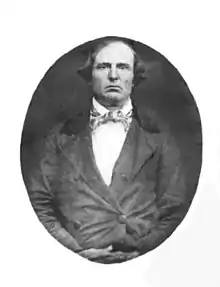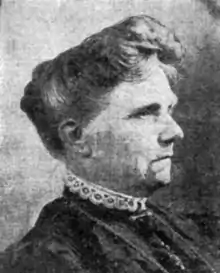Catherine Amanda Coburn
Catherine Amanda Coburn (November 30, 1839 – May 27, 1913) was an American pioneer of the Oregon Territory who, entering the workforce after the untimely death of her husband, became a teacher and school principal and, subsequently, a renowned newspaper editor. A century after her birth, she and her elder sister were described by an Oregon historian as "probably Oregon's two greatest women journalists." She was active in civic life, especially in her later years; though she did not identify as a "suffragette", she did actively support the cause of women's suffrage, among various charitable and civic causes.
Catherine Amanda Coburn | |
|---|---|
 | |
| Born | Catherine Amanda Scott November 30, 1839 Groveland, Illinois, U.S. |
| Died | May 27, 1913 (aged 73) Portland, Oregon, U.S. |
| Resting place | River View Cemetery, Portland |
| Occupation | journalist, newspaper editor |
| Language | English |
| Nationality | American |
| Spouse | John Read Coburn
(m. 1857; died 1868) |
| Children | 4 |
| Relatives | Abigail Scott Duniway, sister Harvey W. Scott, brother Leslie M. Scott, nephew |
Early years

Catherine (nickname, "Kate"[1] or "Kit"[2]) Amanda Scott Coburn was born in Groveland, Illinois, November 30, 1839[3] to John Tucker Scott (1809–1880), originally of Washington County, Kentucky, and Ann Roelofson Scott (1811–1852), originally of Henderson County, Kentucky.[4] She had eight siblings: James, Mary, Abigail, Margaret, Harvey, Harriet, John, Edward, Sarah, William, and Alice. She also had two half-siblings, Ellen and Ward.[5]
On April 1, 1852 the Scott family, along with several others, started for the Oregon Territory, taking the Oregon Trail with a caravan of ox teams. The journey took six months. Ann died on June 20, 1852 when they were in the Black Hills, at a point in the trail about 70 miles (110 km) north of the present city of Cheyenne, Wyoming. She had been sick for only a few hours with what was known as 'plains cholera.' Her husband and nine children, aged from three years and six months to nineteen years, were with her in a shelter tent when she died.[6][7] Amanda's brother "Willie" also died on the Oregon Trail.[2]). Abigail, then seventeen years old, kept a journal during the family's trip west.[8] In later years, Abigail, Harvey, and Kate would go on to share an affinity for the newspaper trade.[5]
In 1857, Catherine married John Read Coburn (1830–1868). The two built a house in Canemah[9] and had four daughters: Agnes, Ada, Camilla, and Kate. Upon John's death in 1868, Catherine became a schoolteacher at Canemah. According to her later account, she was denied her requested salary of US$50 per month, on the basis that the school could "get a man" to teach for that amount. She accepted a salary of $40 per month, continuing in the position for four years, but carried a "rankling sense of injustice." She described the incident as her "first lesson in equal rights."[10] She then became principal of the Forest Grove school, a position she held for two years.[7][11][12]
Career in journalism
In 1874 and for the next five years, Coburn began her career in journalism as associate editor with her sister, Abigail Scott Duniway, editor and publisher of the New Northwest.[13] Coburn evinced a rare degree of journalistic ability. Beginning in 1879, she served for five years as editor in chief of the Portland Daily Bee.[7][12] In the 1880s, Coburn served as associate editor of the Evening Telegram for at least five years, through a period of numerous changes in leadership.[14]
In 1888, she transferred to the editorial staff of the Oregonian, which owned the Telegram. She contributed over the ensuing quarter-century to the daily, weekly, and Sunday editions of the newspaper.[15] Her ability to cover local incidents and interests in editorial comment was credited to her personal connection with the pioneer experience.[7] She remained with the Oregonian as an associate editor until her death in 1913.[5][11] Among her accomplishments as an editorial writer, she was known for "tender tributes to pioneer builders of the Pacific Northwest."[16]

Later years
Coburn was active in civic affairs, especially later in life. She was president of the Allen Preparatory School in Portland, founded in 1901 and incorporated in 1905.[17] She was a member of the Oregon Pioneer Association[18] and a charter member of the Portland Woman's Union, which she represented in bringing a complaint about a Portland schoolteacher.[19] Coburn was elected president of the Woman's Union in 1906.[20] When her sister Abigail brought national woman suffrage leader Susan B. Anthony to Portland's Lewis and Clark Centennial Exposition, Catherine was among those in the receiving line at her speech.[21] Coburn disavowed the term "suffragette," but supported women's suffrage.[10]
She died, following a long illness,[22] in Portland, on May 27, 1913,[23][lower-alpha 1] Leslie M. Scott, her nephew and fellow journalist, praised her career in an obituary;[16] she was buried in that city's River View Cemetery. She left an estate valued at US$14,000 to her daughter Ada and to the children of Agnes and Camilla.[24] George Turnbull, historian of Oregon newspapers, described Catherine and Abigail in 1939 as "probably Oregon's two greatest women journalists.[25]
Notes
- Oregon Historical Society (1940) records date of death as May 28.[3]
References
Citations
- Shein & Penry 2002, p. 18.
- Wadsworth 2003, p. 170.
- Oregon Historical Society 1940, p. 396.
- Cutter 1922, p. 4.
- Oregon Historical Society 1997, p. 157.
- Esarey 1921, p. 97.
- Douthit 1905, p. 173.
- Oregon Historical Society 1918, News and Comment.
- "Moss-Grown Canemah Conjures Days of '50s". The Sunday Oregonian. July 26, 1914.
- "Why We Should Vote: Mrs. Catherine A. Coburn Relates Instances of Injustice". The Sunday Oregonian. February 25, 1912.
- Duniway 2001, p. 33.
- Gaston 1911, Volume 3: John Tucker Scott.
- Duniway 2000, p. 207.
- Turnbull 1939, The Evening Telegram.
- Gaston 1911, Volume 1, Chapter 29.
- Scott, Leslie (May 30, 1913). "Tribute Paid to Late Catharine A. Coburn: Tender Tributes to Pioneers of Northwest, by Late Writer, Distinguishing Mark of Editorial Page". The Morning Oregonian.
- Gaston 1911, Volume 1, Chapter 20.
- Oregon Pioneer Association. Reunion 1902, p. 396.
- "Serious Charges Against Teacher: Said to have appeared in his class room in condition of intoxication". The Oregon Daily Journal. December 6, 1904.
- "New President Portland Woman's Union". The Oregonian. May 6, 1906.
- "Ovation Given Miss Anthony: Leader of Equal Suffrage Warmly Greeted at the Exposition". The Oregonian. July 1, 1905.
- "Mrs. Coburn Improving". The Sunday Oregonian. November 24, 1912.
- Holmes & Duniway 1995, p. 33.
- "City News in Brief: Mrs. Coburn's Estate $14,000". The Morning Oregonian. June 5, 1913.
- Turnbull 1939, Harvey Scott, the Leader.
Bibliography
- Cutter, William Richard (1922). American Biography: A New Cyclopedia (Public domain ed.). American Historical Society.CS1 maint: ref=harv (link)
- Douthit, Mary Osborn (1905). . (Public domain ed.). Presses of Anderson & Duniway Company.CS1 maint: ref=harv (link)
- Duniway, Abigail Scott (1 January 2000). Edna and John: A Romance of Idaho Flat. Washington State University Press. ISBN 978-0-87422-188-6.CS1 maint: ref=harv (link)
- Duniway, Abigail Scott (2001). "Yours for Liberty": Selections from Abigail Scott Duniway's Suffrage Newspaper. Oregon State University Press. ISBN 978-0-87071-474-0.CS1 maint: ref=harv (link)
- Esarey, Logan (1921). Indiana Magazine of History. 17–18 (Public domain ed.).CS1 maint: ref=harv (link)
- Holmes, Kenneth L.; Duniway, David (1995). Covered Wagon Women: 1852, The Oregon Trail. University of Nebraska Press. ISBN 0-8032-7294-4.CS1 maint: ref=harv (link)
- Gaston, Joseph (1911). .CS1 maint: ref=harv (link)
- Oregon Historical Society (1918). . 19.CS1 maint: ref=harv (link)
- Oregon Historical Society (1940). Oregon Historical Quarterly. 41. W.H. Leeds, State Printer.CS1 maint: ref=harv (link)
- Oregon Historical Society (1997). Oregon Historical Quarterly. 98. Oregon Historical Society.CS1 maint: ref=harv (link)
- Oregon Pioneer Association. Reunion (1902). Transactions of the ... Annual Reunion of the Oregon Pioneer Association (Public domain ed.).CS1 maint: ref=harv (link)
- Shein, Debra; Penry, Tara (2002). Abigail Scott Duniway. Boise State University. ISBN 978-0-88430-151-6.CS1 maint: ref=harv (link)
- Turnbull, George S. (1939). . Binfords & Mort.CS1 maint: ref=harv (link)
- Wadsworth, Ginger (2003). Words West: Voices of Young Pioneers. Houghton Mifflin Harcourt. ISBN 0-618-23475-6.CS1 maint: ref=harv (link)
External links
| Wikisource has original works written by or about: Catherine Amanda Coburn |